Andover, N.J.
My visit on
June 8, 2001; pictures from that visit.
Ramblings of an old man....
This is the place where I spent so many summers, or parts of summers, from about 1944 to about 1956. In 1944, gasoline and tires were not only rationed, but were hard to find, thus many kids went to camp on the train. The Lackawanna had service to Andover. Usually you had to take the electric service to Dover, then change to a steam train for the rest of the trip. I occasionally took the "milk" train from Madison. It was steam service all the way from Hoboken to beyond Andover, and left Madison about 5:15 am. There were staff people on the trains to meet and collect the campers. We walked the mile and a half or so from the Andover to camp. It was a pleasant rural walk, past cows and corn after the turn off the US highway. Back in those days the highway was just another country road, there wasn't much traffic, so it was a relatively safe hike.
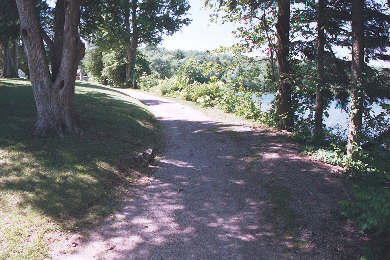 This is how the road along the lake, next to the old
farmhouse, looks today. It looked about the same 65 years ago.
When I was a camper, all who entered or left camp passed by on this road. This is how the road along the lake, next to the old
farmhouse, looks today. It looked about the same 65 years ago.
When I was a camper, all who entered or left camp passed by on this road. |
One of the people who met that train and helped get the kids to camp was Fritz Nagel, a member of the camp committee and strong supporter of the camp. I recall walking with him, and that he helped carry my bags part of the way (seems to me I carried shopping bags). How different is was in the 50's (and is today) when everyone arrived in cars and drove them right to the cabin areas to unload! |
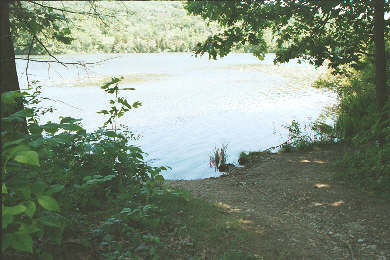 The sink-easy area, as it looks today. Not too different from 40 years ago, except the iris now growing at the water's edge never would have survived all those swimming lessons. The sink-easy area, as it looks today. Not too different from 40 years ago, except the iris now growing at the water's edge never would have survived all those swimming lessons. |
The road in passed through the bigWAWAYANDA gate, then to the right so as to pass between the old farmhouse (still there today) and the lakeshore. The picture (top of page) shows the road, and that's one of the few places that it looks about the same today as it did fifty years ago. There aren't any vehicles on that piece of road now, but it was nice to see it pretty much unchanged. Everything else IS changed! |
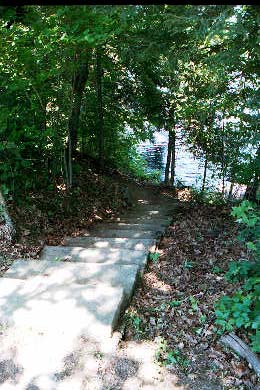 Stairs down to the main swimming dock. The stairs has a little landing half way down, then continues down to the water level. Rowboats were docked where you see water, at the bottom of the stairs. Stairs down to the main swimming dock. The stairs has a little landing half way down, then continues down to the water level. Rowboats were docked where you see water, at the bottom of the stairs. |
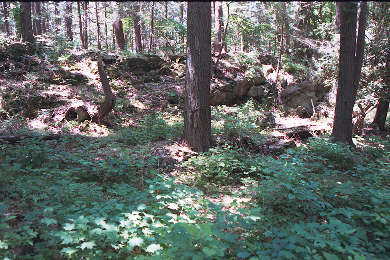 Remains of the Kilbourne Chapel. Not much! But I remember what a beautiful spot it used to be. Remains of the Kilbourne Chapel. Not much! But I remember what a beautiful spot it used to be. |
| That WAS a great place to swim. The water was cold, clear, and deep. There were several diving boards (wait until the lifeguard was sure the landing spot was clear), a couple of slides, a low tower (8 feet), and a high tower (15 feet). It was very exciting for us little kids to get up our nerve to jump off that high tower. One of the diving boards was about four feet above water level; the concrete support for that board remains today. On that day in June 2001 when I visited, the water level was so high that the dock was under a couple of inches of water. I don't recall seeing it that high before. Of course I was not generally in camp so early in June. Seeing the dock that way added to my alien visitor status! Maybe I'll go back again just to get a good picture of that old dock I loved so much. The outdoor chapel was built back a little way in the woods, up a little from the main ground level. I did manage to find a few remains. It was a very pretty spot in those days. We hauled a foot pumped reed organ up there, and we hung a set of chimes to support hymn singing. There was a slightly raised dais, with cedar railings, a pulpit from natural stones, and wooden benches to sit on. The picture you see (above left) bears almost no resemblance to what I remember. That much was hard to find! Incidentally, one of the jokes they used to play on unsuspecting newcomers was to tell them that they had been assigned the job of washing the chapel windows. They were sent to one end of camp to get a huge ladder, then to the other end to get the buckets and rags. They were warned of all the dire consequences, should they break one of those fragile panes. Then they were sent up the trail with all their stuff. But of course there never were any chapel windows. But there was a beautiful chapel. |
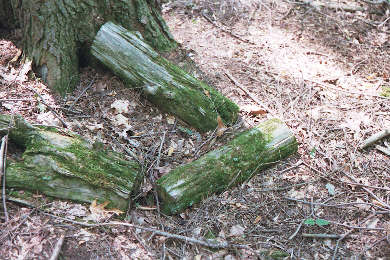 Not much left of the Main Council Ring. I found the place where it had been, but there was nothing left but these old logs. They might have once served as bench supports; they use a lot of cedar in those days! Not much left of the Main Council Ring. I found the place where it had been, but there was nothing left but these old logs. They might have once served as bench supports; they use a lot of cedar in those days! |
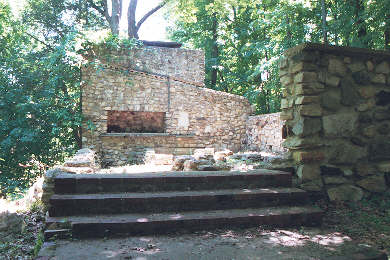 Outpost Lodge.
I came by chance on the most impressive structure remaining: the Outpost lodge. It was perhaps the last structure built at the Andover site. The roof and floor are gone, but the walls and fireplace remain. It's back in the woods now, but in those days you could look out over the camp from the railing on the east side. There was an enclosed room in the NW corner, but the East side of the lodge was open. I don't recall seeing many fires in the mammoth fireplace. I do have recollections of coming into the main dinning hall on a cold morning to find a fire going there. Outpost lodge must have been a great place to be on a rainy day, or for an evening program. Outpost village was just to the South, down a short hill. This lodge was also where the campcraft activity was based: learn how to build a fire, use a hatchet, set up a tent, and so forth. Outpost Lodge.
I came by chance on the most impressive structure remaining: the Outpost lodge. It was perhaps the last structure built at the Andover site. The roof and floor are gone, but the walls and fireplace remain. It's back in the woods now, but in those days you could look out over the camp from the railing on the east side. There was an enclosed room in the NW corner, but the East side of the lodge was open. I don't recall seeing many fires in the mammoth fireplace. I do have recollections of coming into the main dinning hall on a cold morning to find a fire going there. Outpost lodge must have been a great place to be on a rainy day, or for an evening program. Outpost village was just to the South, down a short hill. This lodge was also where the campcraft activity was based: learn how to build a fire, use a hatchet, set up a tent, and so forth. |
|
 It was my job for quite a few years to be camp bugler. Reveille at 7:30am, first call and mess call for meals, swim call (actually assembly) for swim, colors and retreat for the flag, and of course taps. Flag raising and lowering was always part of the routine, so I was surprised to see what looked like the old flagpole, even forty years later. It MUST be the same flagpole, since no one would have put up an old wooden thing like that, even 40 years ago! But there it stands:
the tallest relic around! Anyone out there recall the little carbide cannon we used to fire as a salute? Can anyone still remember the bugle tune "colors" or "retreat". We always folded the flag carefully and properly after we took it down every evening.
It was my job for quite a few years to be camp bugler. Reveille at 7:30am, first call and mess call for meals, swim call (actually assembly) for swim, colors and retreat for the flag, and of course taps. Flag raising and lowering was always part of the routine, so I was surprised to see what looked like the old flagpole, even forty years later. It MUST be the same flagpole, since no one would have put up an old wooden thing like that, even 40 years ago! But there it stands:
the tallest relic around! Anyone out there recall the little carbide cannon we used to fire as a salute? Can anyone still remember the bugle tune "colors" or "retreat". We always folded the flag carefully and properly after we took it down every evening.